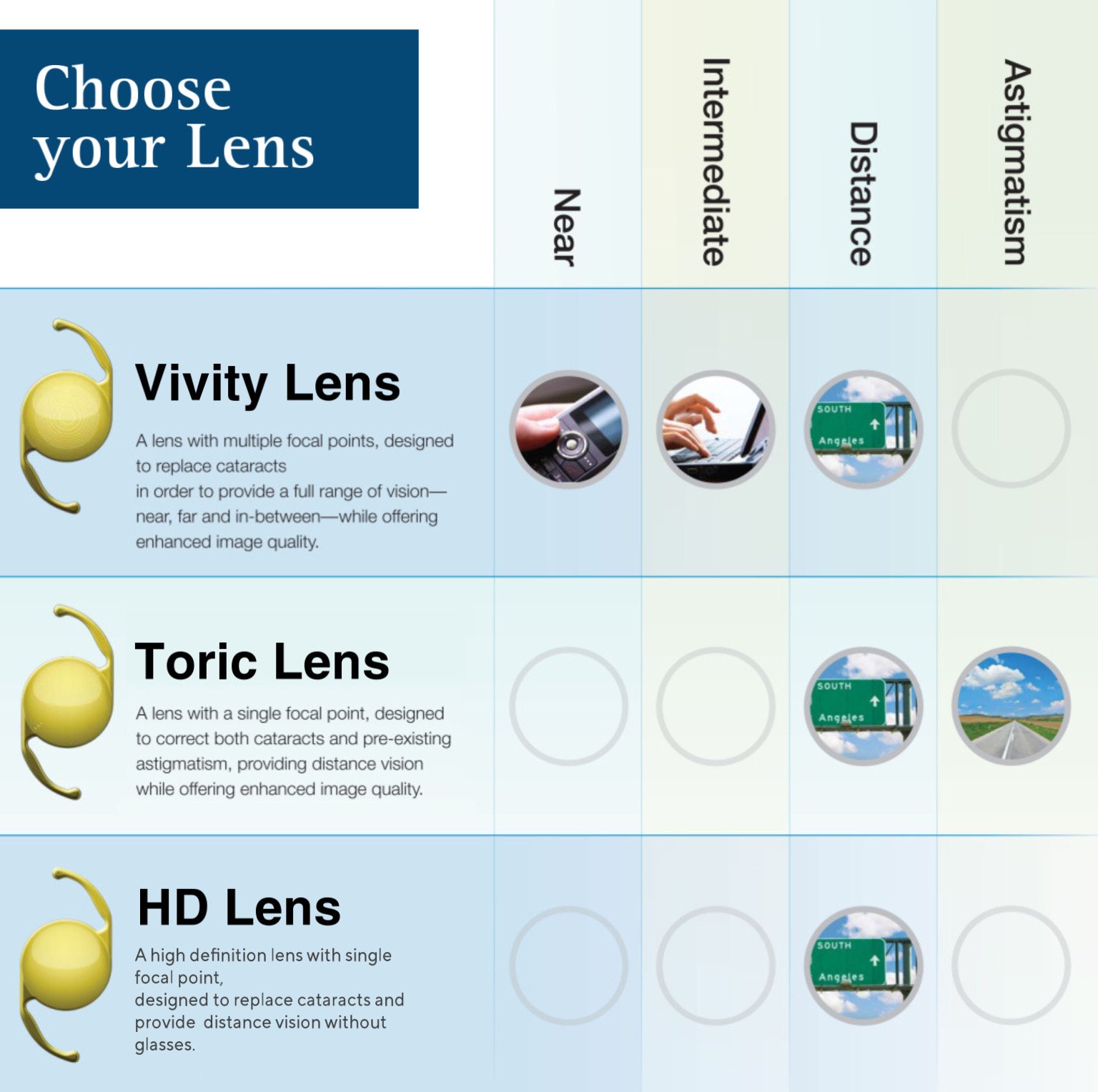What is an Intraocular Lens?
Perich Eye Centers
〰️
Perich Eye Centers 〰️
If you are considering cataract surgery, you may have heard about intraocular lenses. With many variations, it can be confusing to understand and keep up with all the new terminology coming your way. With over 35 years of experience, and over 65,000 cataract surgery cases performed by surgeons at the Perich Eye Center, we have expertise in the surgical correction of cataracts. Additionally, we specialize in the the latest technologies and premium lenses. We understand and are here to break it down for you.
What is an Introcular Lens?
An intraocular lens (IOL) is an artificial lens implanted inside the eye during cataract surgery or, in some cases, refractive lens exchange surgery. The lens is designed to replace the natural lens that has become cloudy or opaque due to cataracts or to correct refractive errors. Just like there are different models of cars and refrigerators, there are different models and functions of Intraocular lenses (IOL).
Here are some key points about intraocular lenses:
Purpose: The primary purpose of an IOL is to restore clear vision after the removal of a clouded natural lens affected by cataracts. It focuses light onto the retina, allowing for improved vision.
Material: Intraocular lenses are typically made of a biocompatible material, such as silicone or acrylic. These materials are well-tolerated by the eye and remain stable within the eye for an extended period.
Types: There are different types of intraocular lenses available, each with its own characteristics and capabilities:
a. Monofocal IOLs: These lenses provide clear vision at a single focal point, usually for distance vision. They may require the use of glasses for near or intermediate vision.
b. Multifocal IOLs: These lenses have multiple focal points, allowing for improved vision at different distances. They can provide clear vision for both near and distance vision, reducing the dependence on glasses.
c. Toric IOLs: These specialized lenses are designed to correct astigmatism, a condition caused by an irregularly shaped cornea. Toric IOLs can address both the cataract and astigmatism, reducing the need for additional astigmatism-correcting glasses or contact lenses.
d. Accommodating IOLs: These lenses are designed to mimic the natural focusing ability of the eye, allowing for better vision at various distances. They provide a greater range of vision without relying on glasses.
Surgical Procedure: The insertion of an IOL involves removing the clouded natural lens through a process called phacoemulsification. After the lens is removed, the IOL is carefully inserted into the same capsular bag that held the natural lens. The IOL remains in place permanently.
Personalization: The choice of an intraocular lens depends on various factors, including the patient's vision needs, lifestyle, and any pre-existing eye conditions. The ophthalmologist will assess these factors and recommend the most suitable IOL for each individual.
Intraocular lenses have revolutionized cataract surgery by restoring clear vision and reducing the need for thick glasses or contact lenses. They can significantly improve visual quality and provide patients with better functional vision at different distances. The key to picking the best IOL for you is evaluating your lifestyle needs to help assess your options.
As with most everything in life, there are a variety of options with different benefits and drawbacks. This chart hopefully can help you to understand the various IOL to then speak with your doctor more informed.
Are HD lens, Toric lens, and Vivity lens covered by your insurance?
No. All these IOLs, including HD lens, Toric lens (astigmatism-correcting), and Vivity lens are advanced technology lenses. There is an extra cost for them. Medicare and commercial insurance do not cover advanced technology IOL for cataract surgery. Premium upgrades to advanced technology lenses must be paid for out-of-pocket by the patient. However, there are other ways to pay for upgrades for cataract surgery. The most common way is your Flexible Spending Card.
You can use Flexible Spending Card provided to you by your insurance towards upgrades on your cataract surgery. For the best outcome with premium lenses, your Flex Spending Card could be the answer to stay in budget. Use your FSA today towards upgrades on your cataract IOL. Ask your insurance provider about details or give us a call 727-372-1311.
Ask your insurance provider about details or give us a call 727-372-1311. We have many convenient locations throughout Central Florida to provide you with the best care with us here at Perich Eye Centers.






